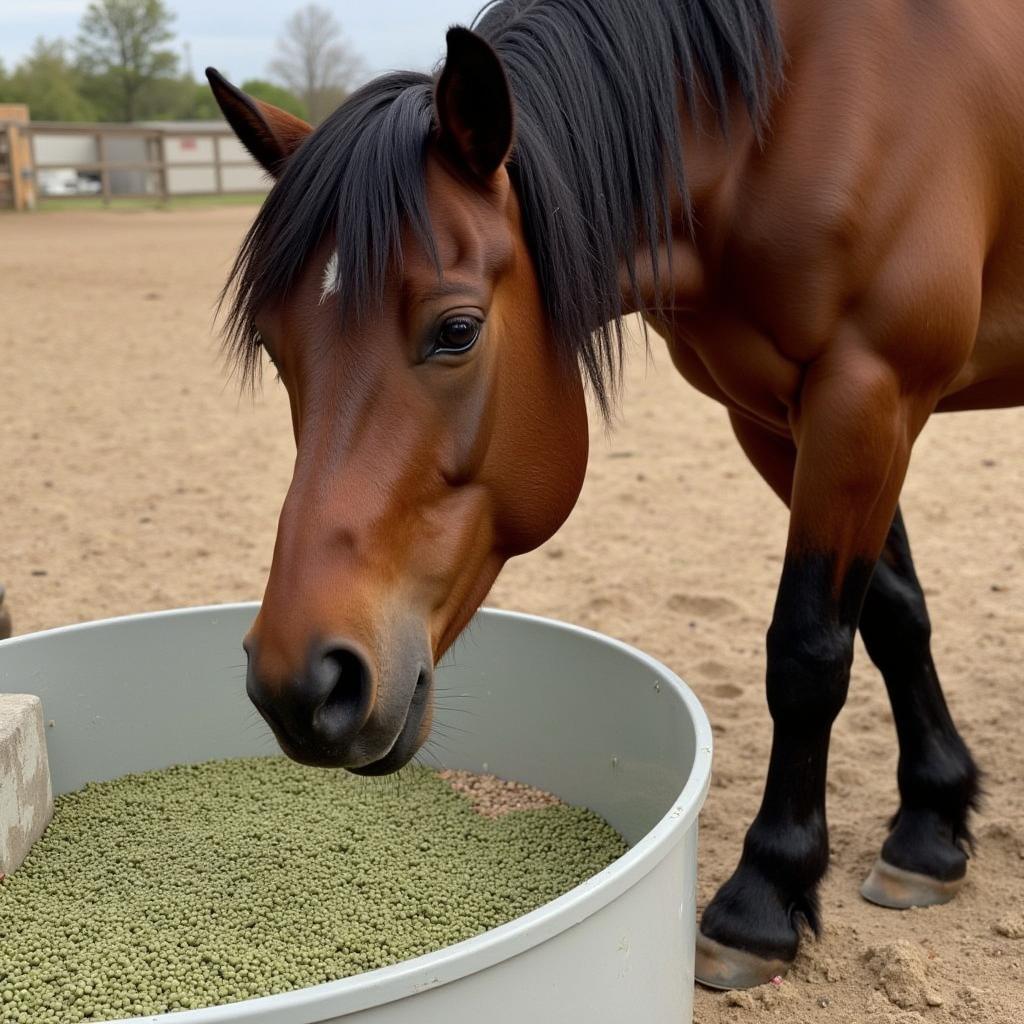Timothy pellets are a popular forage option for horses, but are they the right choice for your equine companion? This comprehensive guide will delve into the benefits, drawbacks, and everything you need to know about incorporating timothy pellets into your horse’s diet.
Understanding Timothy Pellets
Timothy pellets are created by grinding timothy hay into a fine consistency and then compressing it into pellet form. This process offers several advantages over traditional hay, such as:
- Reduced Waste: The compact nature of pellets minimizes mess and reduces waste, making them a more economical choice for many horse owners.
- Consistent Quality: Unlike hay, which can vary significantly in quality depending on factors like harvesting and storage conditions, timothy pellets offer a consistent nutritional profile.
- Convenient Storage: Timothy pellets are easy to store and transport, taking up less space than traditional bales of hay.
Nutritional Value of Timothy Pellets
Timothy hay, in general, is known for being low in calories, protein, and sugar, making it a suitable forage choice for many horses. Here’s a closer look at the nutritional breakdown of timothy pellets:
- Fiber: Timothy pellets are an excellent source of fiber, which is essential for maintaining a healthy digestive system in horses.
- Calories: The calorie content of timothy pellets is relatively low, making them a good option for horses prone to weight gain or those with metabolic issues.
- Protein: With moderate protein levels, timothy pellets can be a suitable forage choice for many horses, particularly those with lower protein requirements.
When Are Timothy Pellets a Good Option?
Timothy pellets can be a valuable addition to a horse’s diet in various situations:
- Hard Keepers: Horses that struggle to maintain weight can benefit from the concentrated calories in timothy pellets.
- Dental Issues: Horses with dental problems that make chewing hay difficult can more easily consume timothy pellets.
- Supplementing Pasture: When pasture quality or availability is limited, timothy pellets can provide essential nutrients.
 A bay horse enjoys a meal of timothy pellets
A bay horse enjoys a meal of timothy pellets
Potential Drawbacks of Timothy Pellets
While generally considered a safe and healthy forage option, there are a few potential drawbacks to consider:
- Choking Risk: Horses should be introduced to timothy pellets gradually to prevent choking, especially if they are not accustomed to pelleted feeds.
- Dust: Some horses may be sensitive to the dust produced by timothy pellets. Soaking the pellets in water before feeding can help mitigate this issue.
- Overconsumption: Monitoring your horse’s intake of timothy pellets is crucial, as overconsumption can lead to weight gain or digestive upset.
Incorporating Timothy Pellets into Your Horse’s Diet
When introducing timothy pellets to your horse’s diet, it’s essential to do so gradually. Start by replacing a small portion of their regular hay ration with timothy pellets and slowly increase the amount over time. Always ensure your horse has access to fresh, clean water when consuming timothy pellets.
Choosing the Right Timothy Pellets
Not all timothy pellets are created equal. When selecting timothy pellets for your horse, consider these factors:
- Quality: Opt for pellets made from high-quality timothy hay that is free from mold, dust, and weeds.
- Pellet Size: Choose a pellet size that is appropriate for your horse’s age and chewing ability.
- Additives: Some timothy pellets may contain added vitamins, minerals, or flavorings. Consider your horse’s individual needs when deciding whether or not to choose pellets with additives.
Timothy Pellets: A Valuable Forage Choice
Timothy pellets can be a beneficial addition to a horse’s diet, offering convenience, consistent quality, and nutritional value. By understanding the benefits, drawbacks, and best practices for feeding timothy pellets, you can make informed decisions about incorporating this versatile forage source into your horse’s feeding program.
FAQs About Timothy Pellets for Horses
Q: Can I feed timothy pellets as the sole source of forage for my horse?
A: While timothy pellets can make up a significant portion of a horse’s diet, it’s generally not recommended to feed them as the sole source of forage. Providing access to long-stem hay is essential for promoting natural grazing behavior and supporting digestive health.
Q: How much timothy pellets should I feed my horse?
A: The appropriate amount of timothy pellets for your horse will depend on various factors, including their age, activity level, and overall health. It’s best to consult with your veterinarian or an equine nutritionist to determine the optimal feeding rate for your horse.
Q: Can I feed timothy pellets to my pregnant or lactating mare?
A: Timothy pellets can be a suitable forage choice for pregnant and lactating mares, but it’s essential to ensure they are receiving adequate nutrition to support their increased needs. Consult with your veterinarian for guidance on adjusting your mare’s diet during these critical stages.
Need More Help?
For personalized advice on incorporating timothy pellets into your horse’s diet, contact our experts at Phone Number: 0772127271, Email: [email protected] or visit us at QGM2+WX2, Vị Trung, Vị Thuỷ, Hậu Giang, Việt Nam. Our team is available 24/7 to assist you.
You can also find more information on our website about various horse care topics. If you’re interested in learning more about horse cumshot.compilation, we have a dedicated page with detailed information.